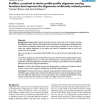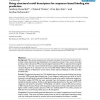69 search results - page 11 / 14 » Prediction of the Number of Residue Contacts in Proteins |
BMCBI
2005
13 years 7 months ago
2005
Background: Profile-profile methods have been used for some years now to detect and align homologous proteins. The best such methods use information from the background distributi...
CSB
2004
IEEE
13 years 11 months ago
2004
IEEE
One goal of the structural genomics initiative is the identification of new protein folds. Sequence-based structural homology prediction methods are an important means for priorit...
BMCBI
2002
13 years 7 months ago
2002
Background: Post transcriptional gene silencing (PTGS) is a recently discovered phenomenon that is an area of intense research interest. Components of the PTGS machinery are being...
BMCBI
2007
13 years 7 months ago
2007
Background: Many protein sequences are still poorly annotated. Functional characterization of a protein is often improved by the identification of its interaction partners. Here, ...
CIKM
2009
Springer
14 years 2 months ago
2009
Springer
Background: Although both conservation and correlated mutation (CM) are important information reflecting the different sorts of context in multiple sequence alignment, most of ali...


